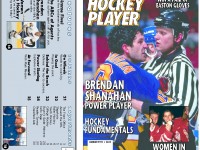Creating explosive starts

Fast starts are vitally important in ice hockey. Whenever I work with pro players—from the LA Kings to National Team players in Europe—the skating skill that they like to work on the most is, inevitably, the explosive start. And this holds true whether they are defensemen or forwards. They like to work on bettering their starts because they realize that with the proper techniques and training they can improve their overall quickness.
Getting an explosive start can be just as important in hockey as one’s straight-ahead speed, since hockey is a sport of short bursts and change of directions. This month’s article will introduce you to, and focus on the techniques for front forward starts that should help you “get the lead out” of your skates.
Forward Starts
Techniques
Make sure you start with your skates directly under your body, forming the letter “V”—with your heels together and knees turned outward. It is very important that you maintain this narrow base throughout the start.
Bend the knees to 90°. Then thrust your body forward by applying 100% of your body weight to the front part of the pushing foot’s inside edge (the toe of the skate). You should land on the front part of the other skate’s inside edge, and then repeat the move again.
To gain that quick off-the-mark start, take your initial three strides as described above, with the push coming from the toe part of the inside edge of your skate blade. This will give you that explosive running motion that you often see from quickest players in the NHL, like Wayne Gretzky and Sergei Federov.
Helpful Hints
To gain an explosive start, you should picture in your mind what a sprinter looks like when the gun goes off. The sprinter is trying to thrust forward—not upward—to gain that extra advantage at the start, and their initial strides come from the balls of the feet. It is extremely similar in hockey. We want to feel like we are thrusting forward; taking quick strides that may look like short strides to the naked eye but are, in fact, best performed when fully extending the pushing leg. Remember to stay low throughout the move, trying to cover as much distance as you can while still making very rapid strides.
Drill
The ability to get up on the toes of your skates is the first step in improving your start, and an excellent drill to improve this skill is one I call “The Penguin,” or the “Charlie Chaplin.” To start the exercise, place your feet in the “V” position, bending your knees deeply and turning them outward. Then attempt to lift your heels off the ice so that you are standing only on the toes of your inside edges. Once you get the proper balance, begin to walk slowly across the ice while only on the toes of your skates (like a penguin, or Chaplin). If you can stay only on the inside edge of the toe for at least four strides while walking slowly, that would be an excellent result—and that ability will help you to get on your toes for more dynamic starts in game situations.
Once you feel confident walking on your toes, add some speed to the drill. Begin by walking slowly on the toes of your inside edges, like Chaplin again, for about five strides, then attempt to build up speed with the next three-to-four strides—doing the same drill, but now at game speed. You should really begin to feel the explosive start. Remember to exaggerate all these movements in practice so that in the games you do not have to think about them.
Be patient
If you read this column regularly, you then know that we urge you not to got discouraged or lose your confidence if you have trouble applying some of the techniques we describe. This is doubly important when practicing the explosive start. I have pro players who return to me frequently to work specifically on their starts, and getting up on the toes of the skates is extremely difficult even for these highly skilled players.
So be patient, and do not be afraid to fall down or make mistakes. As is so often the case when working on your skating skills, falling forward when practicing explosive starts only shows that you are making a good effort to improve them.
Robby Glantz is an internationally certified Laura Stamm instructor. He is a power skating coach for the Los Angeles Kings, European champion Malmö, Sweden and the German National Teams. He conducts Power Skating schools for all levels throughout the U.S.
This first appeared in the 01/1995 issue of Hockey Player Magazine®
© Copyright 1991-2011 Hockey Player® and Hockey Player Magazine®


